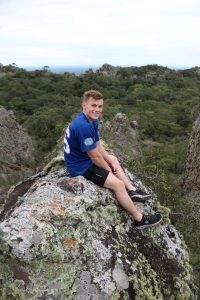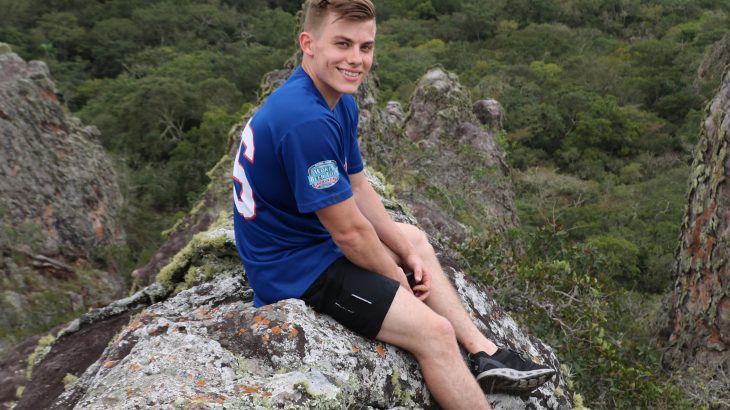This post was written by Alexander Freeman, a Petroleum Engineering Senior. He recently traveled to Bolivia with MCEE International Programs as a part of a study abroad component students can take. These students take an OU PE course, taught by an OU PE faculty member and earn credit towards their degree.
Our two-week trip to Santa Cruz, Bolivia was divided into two separate parts. The first week was spent touring the countryside and immersing ourselves in the Bolivian culture. The second week was devoted to the actual course we came all this way to take. To begin our week of exploring we set off to Samaipata, Bolivia. On our journey there, we were accompanied by two locals, Freddy and Rolando (Roli for short). For lunch we stopped at the Amboro National Park located in the Andean foothills of Bolivia. The park consisted of a network of cascades and waterfalls zigzagging through one another. We spent the next couple of hours tracking through the jungle going from one cascade to another soaking up all the esthetic beauties each had to offer. After lunch we headed to the small town of Samaipata where we were given a tour of 1750 Vineyards. 1750 stood for the elevation at which the grapes of the winery were grown. We were first educated over the facilities and processes that went into preparing each bottle of wine. After being properly educated we were given the opportunity to taste several of the vineyards most popular wines. After a couple of hours of chatting and enjoying the good wine we thanked our hosts, loaded back onto the bus, and headed for Santa Cruz.

Over the course of the next three days Roli and Freddy drove us all around the Bolivian countryside. We went from town to town meeting locals who seemed to always welcome us with open arms. Whether we stopped for gas or a hot meal, every local we encountered was always very generous and hospitable. During our tour of the countryside we stayed at a very famous locally run inn located in the small town of San Jose De Chiquitos, called Villa Chiquitana. Many famous people had stayed there in the past including the Queen of Spain in 2012. While there we visited Valle De Luna (Valley of the Moon) and hiked the trail that winded through it. We also toured a church that was built near the end of the Spanish Inquisition. It had been renovated many times but still had the same structure as it did when it was built over 200 years ago. More of our adventures included visiting the largest hot spring in Bolivia called Aguas Calientes. We also toured the ruins of a pre-Incan civilization (14th century), known as El Fuerte de Samaipata. The ruins sat atop a small mountain at the base of the Andes and served as a place for it’s inhabitants to conduct rituals and sacrifices for their gods.
To conclude our week of cultural emersion, we journeyed to a small town in the southeast corner of Bolivia known as La Pajcha. We were there to visit a famous cascade located at the top of a nearby mountain. Once there, we ate lunch with a local family then began our trek up the mountain. The roads we took weren’t really roads at all. They were composed of mostly of dirt and rock. We made it a little over half way up the mountain when it began to rain. The rain made the roads impossible to drive up, especially at the incline they were at. Unfortunately, due to the dangerous road conditions we weren’t able to make it to the cascade but the trip there was still quite exciting.
The second week of our trip was spent mostly at UPSA (Universidad Privada de Santa Cruz) where we took a course over decline curve analysis taught by OU’s own Dr. Callard. We would spend most of our day in the classroom with the exception of a very long lunch break taken around noon each day. The students at the university were very friendly and always made it a priority to get to know us even if their English wasn’t strong. We became very good friends with some of the students and would meet up with them frequently to check out some of their favorite places around the town. On the last day of our trip a few of the students from the university took us to a professional soccer game in the heart of Santa Cruz. The  stadium was quite old and had definitely seen better days but when the game started the fans came alive like I had never seen before. I hadn’t realized how devoted soccer fans were until watching that game. More than half the fans at the game were crammed into a small part of the stadium above one of the goals. They sang ‘fight songs’ and screamed chants the entire time, even during halftime. I couldn’t believe how much love they had for their team.
stadium was quite old and had definitely seen better days but when the game started the fans came alive like I had never seen before. I hadn’t realized how devoted soccer fans were until watching that game. More than half the fans at the game were crammed into a small part of the stadium above one of the goals. They sang ‘fight songs’ and screamed chants the entire time, even during halftime. I couldn’t believe how much love they had for their team.
Visiting Bolivia was the first time I had ever been out of the country. One of the main takeaways I got from the trip was appreciation for what I had and what I had become accustomed to in the states. I also gained a lot of respect for the students we met at the University. The majority of students we met spoke at least two languages, some even three or four. Not to mention they were taking a very difficult class taught by a foreign professor who spoke a language much different then there’s. Seeing the students overcome such a language gap really made we want to learn a second language and is something I hope to achieve in the future. The week spent touring the Bolivian countryside was very enlightening. I learned many things about the Spanish culture and got to see some of the most famous sights and attractions Bolivia had to offer. Studying abroad in Santa Cruz was definitely a life changing experience. To anyone considering studying abroad in a foreign country, I highly suggest it. You will never be the same after.
